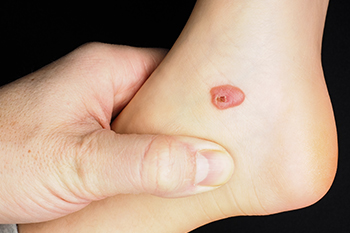
Blood blisters on the foot are caused by friction or trauma that ruptures blood vessels under the skin without breaking the surface. This can occur from wearing ill-fitting shoes, engaging in vigorous activities, or sudden impact injuries. The resulting blister is filled with blood due to the broken capillaries beneath the skin. Blood blisters are generally more painful than regular blisters because of the pressure from the trapped blood. They typically last for about one to two weeks, during which time the body gradually reabsorbs the blood. To aid healing, it is important to protect the blister from further friction or pressure by using padded bandages and avoiding activities that aggravate the area. If you notice you have a blood blister on your foot, it is suggested that you schedule an appointment with a podiatrist who can help you to manage this condition.
Blisters are prone to making everyday activities extremely uncomfortable. If your feet are hurting, contact Dr. Richard DiMario of Maine. Our doctor can provide the care you need to keep you pain-free and on your feet.
Foot Blisters
Foot blisters develop as a result of constantly wearing tight or ill-fitting footwear. This happens due to the constant rubbing from the shoe, which can often lead to pain.
What Are Foot Blisters?
A foot blister is a small fluid-filled pocket that forms on the upper-most layer of the skin. Blisters are filled with clear fluid and can lead to blood drainage or pus if the area becomes infected.
How Do Blisters Form?
Blisters on the feet are often the result of constant friction of skin and material, usually by shoe rubbing. Walking in sandals, boots, or shoes that don’t fit properly for long periods of time can result in a blister. Having consistent foot moisture and humidity can easily lead to blister formation.
Prevention & Treatment
It is important to properly care for the affected area in order to prevent infection and ease the pain. Do not lance the blister and use a Band-Aid to provide pain relief. Also, be sure to keep your feet dry and wear proper fitting shoes. If you see blood or pus in a blister, seek assistance from a podiatrist.
If you have any questions, please feel free to contact our office located in York, ME . We offer the newest diagnostic and treatment technologies for all your foot care needs.